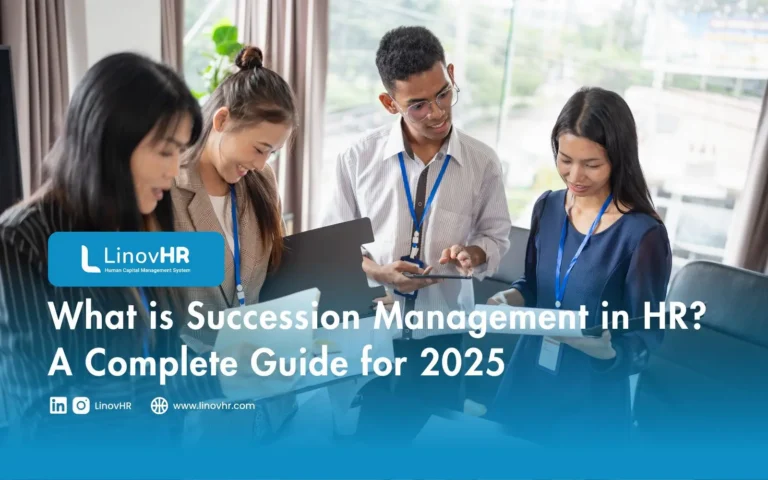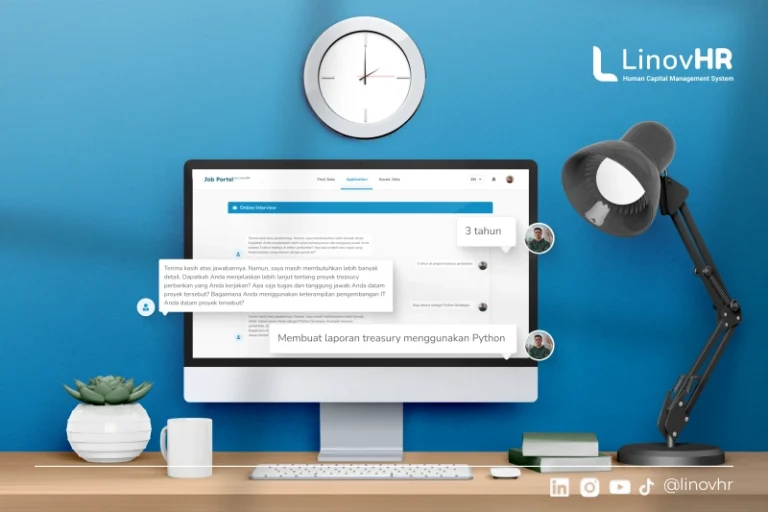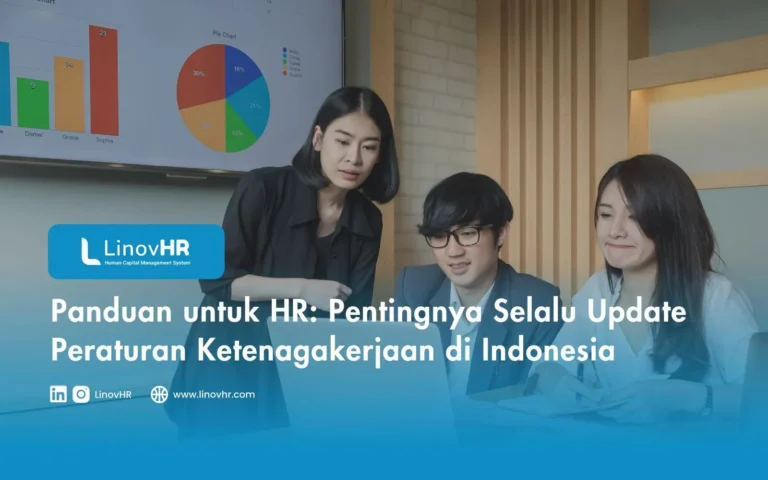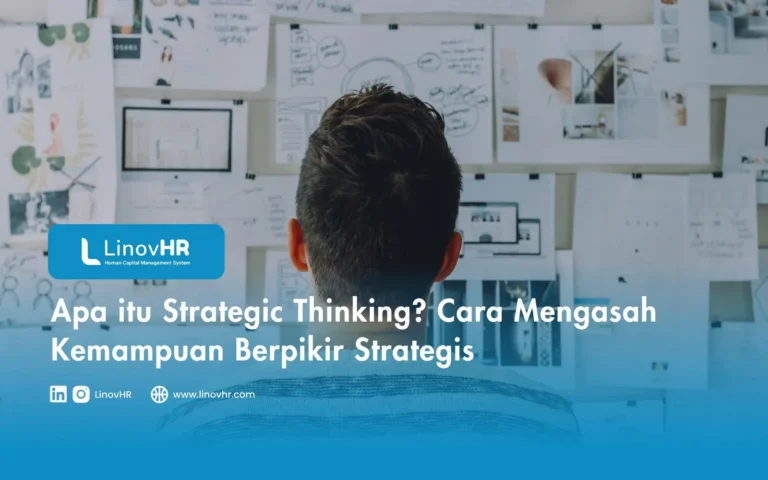Every organization depends on strong leaders to execute strategy, drive performance, and motivate teams. But leadership doesn’t last forever.
That’s why succession management is essential to ensuring a strong, sustainable talent pipeline.
By aligning talent development with future business needs, and leveraging modern HR technology, businesses can confidently fill critical roles from within, avoid costly hiring delays, and nurture the next generation of leaders.
This article will walk you through the core concepts of succession management, its challenges, the best strategies to strengthen your leadership pipeline, and how HR technology like LinovHR can accelerate the process.
What is Succession Management in HR?
Succession management in HR is a strategic, ongoing approach to identifying, developing, and preparing future leaders who can step into critical roles when needed.
Rather than relying solely on external hiring, organizations proactively build a strong internal talent pipeline to ensure business continuity and long-term stability.
While the term is often mistaken for succession planning, the two have different scopes. Succession planning focuses on preparing specific individuals to fill specific key positions.
In contrast, succession management takes a broader, organization-wide perspective, aligning talent development with future business needs, leadership growth, and workforce readiness.
HR plays a central role in this process by evaluating talent potential, supporting employee development programs, and ensuring leadership transitions are smooth and well-prepared.
With strong succession management, companies minimize disruption, reduce hiring risks, and remain resilient in a rapidly changing business landscape.
Why Succession Management Matters in Modern Organizations
Succession management plays a crucial role in maintaining organizational continuity and preparing companies for future challenges.
As workforce demands and market dynamics evolve rapidly, businesses need a strong internal talent pipeline to stay competitive and resilient.
Here are key reasons why succession management is essential today:
Builds a Sustainable Talent Pipeline
By consistently identifying and developing high-potential employees, organizations ensure a reliable supply of future leaders, strengthening business confidence and competitive advantage.
Develops Critical Skills Across the Workforce
Succession management expands capability-building beyond leadership roles, equipping employees with the skills needed to support long-term growth and innovation.
Aligns the Workforce With Business Objectives
With strategic hiring and talent development, organizations ensure they have the right people ready to achieve key goals efficiently and effectively.
Minimizes Disruption From Unexpected Turnover
Preparing internal successors reduces operational risk when key roles suddenly become vacant, enabling smooth transitions and maintaining business momentum.
Enhances Engagement and Reduces Turnover
Employees are more committed when they see clear career opportunities and development pathways. Internal successors also have higher success rates and lower turnover than external hires.
Preserves Critical Institutional Knowledge
Through mentoring and intentional talent development, valuable experience and organizational insight are retained and passed on to future leaders.
Succession Planning vs Succession Management: What’s the Difference?
While succession planning and succession management are closely related, they are not the same.
Both aim to secure future leadership, but they differ in scope, timing, and long-term impact on the organization.
Succession planning is a targeted, role-specific strategy. It focuses on identifying individuals who can replace key leaders when they leave, such as a CEO, CFO, or department head.
This approach is often reactive and short-term, triggered by events like retirement or resignation.
For example, a company may select a senior manager to be the next CEO and provide mentorship over several years to ensure a smooth transition.
Succession management, on the other hand, takes a broader and more proactive approach. Instead of preparing replacements only for top positions, it continuously develops a pipeline of high-potential talent across all levels of the organization.
This ensures skilled leaders are always ready to step into critical roles as the business evolves. An example includes implementing leadership development programs and regularly tracking employee growth.
In summary, succession planning fills immediate leadership needs, while succession management builds long-term organizational strength and agility.
Succession Management Strategies
Succession management is not a one-time process, it must become an integral part of the organization’s culture and long-term talent strategy.
HR plays a key role in embedding succession planning into recruitment, performance reviews, learning programs, and leadership development.
Below are the key strategies that help organizations build a scalable and future-ready leadership pipeline:
1. Build Talent Pools to Enhance Agility
Instead of developing a single successor for a specific role, organizations should form broader talent pools.
These groups consist of high-potential employees who are trained to take on multiple leadership roles as business needs evolve.
This approach increases organizational agility and ensures smooth transitions during leadership changes.
2. Promote Job Rotations and Cross-Training
Future leaders need a holistic understanding of the business.
Job rotations, moving employees across different teams or functions, broaden their skills, expose them to new challenges, and build a more versatile leadership bench.
Cross-training also prepares them to step into critical roles when needed.
3. Implement Mentorship and Leadership Development Programs
A strong leadership bench requires structured development.
Organizations can combine formal leadership training with mentorship programs that connect high-potential talent with experienced leaders.
This allows successors to gain real-world insights into decision-making, leadership styles, and organizational strategy.
Common Challenges in Succession Management
Even well-designed succession management programs can struggle when organizations fail to execute consistently. Below are the most common challenges that hinder success:
1. Lack of Leadership Buy-In
When senior executives see succession management as merely an HR task, they may not commit time to mentoring or talent reviews, weakening accountability and impact across the organization.
2. Resistance from Current Leaders
Some leaders unintentionally block progress by:
- Hoarding talent to benefit their own teams
- Feeling threatened by the idea of preparing their own replacement
This behavior slows mobility and undermines organizational growth.
3. Bias in Talent Identification
Without objective evaluation, decision-makers may fall into biases such as:
- “Mini-Me” syndrome: choosing successors who resemble them
- Confusing performance with potential: overlooking future leadership capabilities
This can limit diversity and innovation in leadership pipelines.
4. Inconsistent or Insufficient Development
Listing successors is not enough. Without stretch assignments, mentoring, and development programs, identified talent will not be truly ready to step into critical roles.
5. Treating Succession as a One-Time Event
A static plan quickly becomes outdated. Succession management must be reviewed continuously to align with shifting business strategies and employee growth.
6. Lack of Transparency
Overly secretive processes can leave high-potential employees unsure of their future in the company, increasing the risk of losing them to competitors. Transparent career pathways encourage engagement and retention.
7. Overemphasis on the C-Suite
Focusing only on top executives neglects other vital roles, such as expert technical specialists or key operational leaders, whose sudden departure could disrupt business continuity just as severely.
Best Practices to Strengthen Succession Management
To build a strong succession management program, organizations must go beyond simply identifying future leaders.
The focus should be on continuously developing talent, aligning planning with the company’s direction, and using objective methods to support growth.
Here are the essential best practices to strengthen succession planning within any business:
1. Align Talent Strategy with Future Business Needs
Succession planning should not only fill today’s roles, it must prepare talent for tomorrow.
Review the organization’s 3–5 year strategic direction to identify emerging skills, leadership styles, and business-critical capabilities.
For instance, if the company is shifting toward AI-driven innovation, future leaders in R&D must be equipped with relevant digital and technology competencies.
2. Secure Executive Involvement and Accountability
Leadership commitment is crucial. Rather than relying on passive approval, make talent development a core KPI for senior leaders.
They should actively mentor high-potential talent and take part in regular, data-driven talent review discussions to ensure progress.
3. Prioritize Development Over Identification
A strong program goes beyond maintaining a list of successors on paper.
Apply the 70-20-10 development approach to ensure future leaders grow through practical experiences, coaching relationships, and structured training.
This creates a continuous pipeline of candidates who are truly prepared for elevated roles.
4. Ensure Objectivity with Data-Driven Tools
To reduce bias and create fair evaluation, implement a standardized assessment framework such as the 9-box grid.
This helps leaders assess both current performance and future potential, revealing hidden talent that may otherwise go unnoticed.
5. Expand Focus Beyond Top Leadership Roles
Critical knowledge and leadership exist at all levels. Identify key positions across the organization that would disrupt operations if left vacant, such as top revenue drivers or specialized technical experts.
Build robust talent pools to ensure stability in every essential function, not just the C-suite.
6. Embed Diversity, Equity, and Inclusion
Effective programs avoid the “mini-me” bias, where leaders choose successors similar to themselves. Regularly audit the talent pipeline to ensure diverse representation.
Encourage mentorship and sponsorship for high-potential talent from underrepresented groups to build a more inclusive future leadership structure.
7. Maintain an ‘Always-On’ Succession Approach
Because business needs shift quickly, succession planning must operate as a living, continuously updated program.
Revisit talent readiness at least quarterly, or immediately following major business changes, to keep plans aligned with current dynamics.
8. Track Progress and Communicate Clearly
Success depends on measurable outcomes. Monitor metrics such as internal fill rates, bench strength, and readiness timelines to deliver tangible results.
Keep the process transparent so employees understand what it takes to advance. Clear communication builds trust and enhances retention among future leaders.
How HR Technology Supports Succession Management
Modern HR technology plays a crucial role in transforming succession management from a traditional, reactive process into a dynamic, data-driven strategy.
Instead of relying on outdated spreadsheets or subjective decision-making, today’s HR systems, such as HRIS and integrated Talent Management platforms, help organizations manage talent more efficiently and objectively.
Here’s how technology enables success at every stage of succession management:
1. Centralizing Employee Data
HR technology provides a single source of truth for all workforce information, including skills, performance history, competencies, and qualifications.
This unified view allows leaders to quickly evaluate talent readiness and make informed decisions based on accurate, real-time data.
2. Identifying High-Potential Talent
With advanced analytics and built-in tools like the 9-box grid, HR software helps organizations objectively identify and compare high-potential employees.
AI-driven insights can even uncover hidden talent outside leadership’s immediate visibility, ensuring a deeper and more diverse pipeline of future leaders.
3. Managing and Tracking Development
Technology ensures that development plans don’t remain static. Through features like individual development plans (IDPs), competency tracking, coaching workflows, and LMS integration, organizations can continuously guide employees toward leadership readiness and monitor measurable growth over time.
4. Visualizing Scenarios and Talent Gaps
Interactive succession dashboards enable leaders to model future scenarios, such as unexpected resignations or retirements.
Tools like dynamic org charts and risk heatmaps make it easier to identify critical roles lacking successors and address vulnerabilities before they disrupt business operations.
5. Supporting Objectivity and Diversity in Leadership Pipelines
Data-based assessments help reduce bias in talent decisions. HR technology enforces consistent evaluation criteria and provides insights into succession pool diversity, supporting more inclusive leadership development and strengthening organizational innovation.
LinovHR: Your Partner in Strategic Succession Management
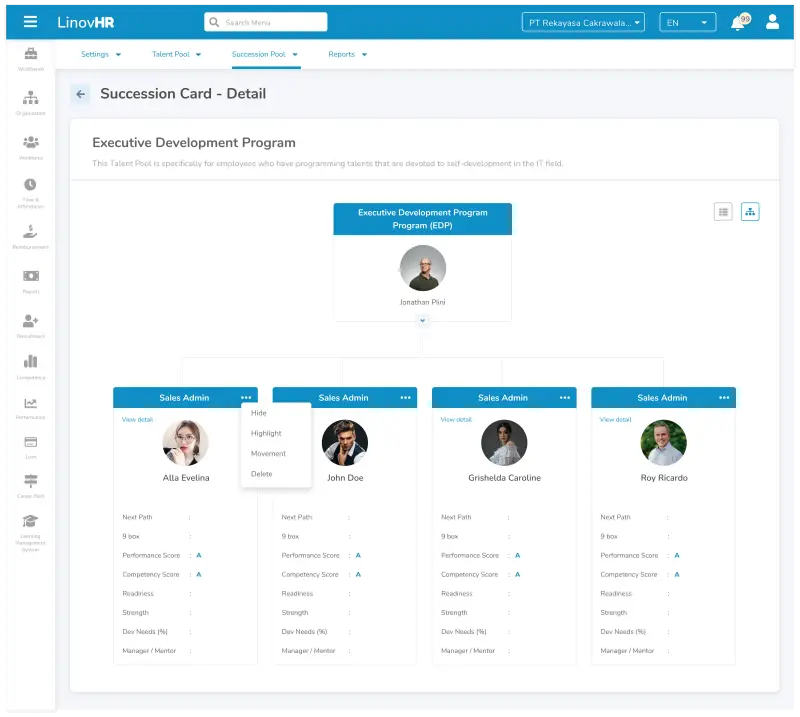
Effective succession management requires the right tools, and LinovHR delivers a comprehensive solution tailored to help organizations build a strong, future-ready leadership pipeline.
With advanced talent mapping, real-time analytics, and employee-driven development features, LinovHR ensures that no critical role is left without a prepared and capable successor.
Here’s how LinovHR supports companies in strengthening leadership continuity:
Robust Talent Pool Management
LinovHR empowers HR teams to identify and develop high-potential employees based on real-time performance and competency data.
Each successor candidate has a complete profile, including skills, achievements, and career history, helping organizations evaluate readiness and leadership potential with confidence.
Data-Driven Insights with the 9-Box Matrix
Avoid biased decisions and guesswork. LinovHR integrates a calibrated 9-box framework that compares current performance with future potential, enabling HR and leaders to make objective talent decisions.
With clear visual mapping, organizations can quickly identify top successors and areas where targeted development is needed.
Dedicated Succession Pool for Critical Roles
LinovHR helps companies categorize and track potential successors for every key role across departments.
With clear visual insights and structured data, HR can ensure that leadership continuity remains aligned with changing business needs and organizational structure.
Empowering Employees to Own Their Growth
Succession management succeeds when employees are actively involved in their career journey. LinovHR offers:
Succession Card
Employees can access personalized insights into their performance evaluation, recommended development programs, and future career opportunities, helping them stay motivated and aligned with career pathways inside the organization.
Self Review Capability
High-potential talent can express their aspirations and assess their own readiness, creating a transparent and collaborative leadership development process.
Why Choose LinovHR?
With LinovHR’s Succession Management Software, organizations gain:
- Better talent identification to secure future leadership
- Stronger continuity planning that prevents leadership gaps
- Reduced hiring time and costs by prioritizing internal leaders
LinovHR ensures your succession plan is not just a document, but a strategic, scalable, and always-on process that drives long-term business success.
Schedule Your Free Demo Today and Start Building Your Future Leaders with LinovHR.


